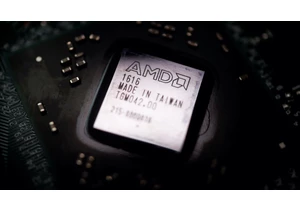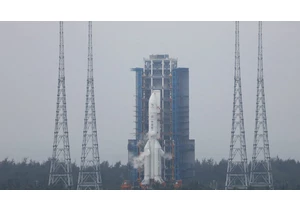After decades of research and development, the U.S. military is officially using laser weapons in combat zones overseas.
The U.S. Army recently disclosed that the service had not only deployed a pair of 20-kilowatt palletized high-energy laser (P-HEL) systems—built on Virginia-based defense contractor BlueHalo’s Locust Laser Weapon System—abroad to protect U.S. troops from hostile drones in recent months, but that those systems had proven successful against incoming threats in the Middle East in the first-ever use of laser weapons in combat.
The successful employment of the P-HEL overseas is a significant milestone for the U.S. military, which has pursued laser weapons for air defense ever since a prototype laser beam developed under Project Delta successfully downed a drone during testing at Kirtland Air Force Base in New Mexico in 1973. In recent years the Pentagon has increasingly invested money and R&D into making operational laser weapons a reality, with roughly 31 active directed-energy projects (which include both lasers and high-powered microwaves) throughout the U.S. military funded to the tune of more than $1 billion annually, per C4ISRNet.
And after decades of research, the P-HEL’s operational deployment can’t come soon enough. Today, U.S. troops and warships across the Middle East find themselves increasingly plagued by weaponized commercial off-the-shelf drones and their military-grade cousins following the start of Israel’s war in Gaza back in October. With three U.S. troops killed in a drone attack in Jordan in January of this year and scores more injured in Iraq and Syria, the rising threat has induced several top military leaders to call on the Pentagon to accelerate the fielding of directed-energy weapons as a cost-effective countermeasure.
In some defense circles, high-energy lasers represent the platonic ideal of a counter-drone air defense system. With the right power source, a laser weapon can fire off a virtually infinite number of shots at the speed of light at a cost of between $1 and $10 each, according to a 2023 Government Accountability Office assessment of the Pentagon’s directed energy efforts—a major contrast to the expensive surface-to-air missiles like those that American forces have been employing to swat Houthi and Iran-backed militia drones out of the sky in recent months.
But despite their ostensible tactical advantages and recent technological progress, laser weapons have remained a notional, unproven counter-drone solution, perpetually on the cusp of either achieving a major breakthrough that could see the systems finally ready for prime time on a complex battlefield or falling into the “valley of death” between development and procurement where too many promising next-generation systems often end up. That the P-HEL is apparently operating with relative ease downrange is, by all measures, a modern technological miracle.
For P-HEL contractor BlueHalo in particular, the deployment of the new laser weapon system is quite the business coup. Founded in 2020 from the union of several smaller defense contractors under the auspices of private equity firm Arlington Capital Partners, BlueHalo specializes in supporting not just counter-drone solutions but also space-based technologies and electronic and cyber warfare—all technologies seen as critical to a U.S military that’s spent the past few years pivoting its focus from counterterror operations in the Middle East to so-called great power competition or near-peer conflict with Russia and China.
“Myself and Arlington Capital [Partners], our financial sponsor . . . we wanted to lead the transformation of global defense,” Jonathan Moneymaker, CEO of BlueHalo, tells Fast Company. “We were coming out of a couple decades focused, appropriately so, on counterterrorism as a mission, and a lot of that came at the expense of technologies or capabilities that would be more relevant in the rise of peer conflict with China, Russia, et cetera.”
Indeed, the rise of weaponized drones hasn’t just become a feature of asymmetric conflicts with irregular forces like the Houthis in Yemen or Iran-backed militias in Iraq and Syria, but also those of conventional militaries, from the 2020 war between Armenia and Azerbaijan over the Nagorno-Karabakh region to Russia’s ongoing invasion in Ukraine. The U.S. military is rapidly accelerating the development of its own attack-drone capabilities to give troops additional firepower in an increasingly complex battlefield. As drones quickly proliferate across militaries worldwide, so must innovative new counter-drone tactics and technologies.
While BlueHalo’s promise of a “global protective ring” around American and allied troops around the world may seem aggressively aspirational, especially for a defense industry defined by technical jargon and military buzzwords, the company’s mission is at its core a personal one for Moneymaker: His brother, Navy Lieutenant Mathew Moneymaker, died serving the United States when his S-3B Viking jet crashed shortly after takeoff from the aircraft carrier USS John F. Kennedy in November 1999.
“He was one of those stereotypical all-American boys, if you will: He loved his country, loved his family, loved flying,” Moneymaker says of his brother. “And for better or for worse, he died doing something that he loved, which on the one hand is fantastic, and on the other hand it marks one of those devastating moments for those left behind.”
Between its directed-energy efforts and contracts with the Pentagon for space-based systems and other various counter-drone solutions, among other products, BlueHalo has grown to 2,400 employees and $1 billion in revenue. And BlueHalo’s approach to directed energy appears to be paying off. In the last year, the company has received contracts from the Defense Department to integrate versions of its Locust system into two next-generation vehicles: the Army’s Infantry Squad Vehicle “assault buggy” and the Marine Corps’s Joint Light Tactical Vehicle that’s set to replace the service’s aging Humvee fleet.
According to Moneymaker, the company is also in discussions with the Navy about potentially providing laser weapons not just for surface warships but also aircraft carriers and even submarines as a low-cost counter-drone solution.
Defense giants like Raytheon, Lockheed Martin, and Northrop Grumman have been slowly lumbering toward functional laser weapons since the turn of the century. In recent years, several systems—like the Arleigh Burke-class destroyer USS Preble’s 60-kilowatt high-energy laser with integrated optical-dazzler and surveillance (HELIOS), and the Stryker-mounted 50-kilowatt directed-energy maneuver short-range air defense (DE M-SHORAD)—have been undergoing “real-world testing” in the hands of U.S. troops to see how they fare outside the controlled environs of a lab.
But BlueHalo has distinguished itself from legacy defense contractors in developing, testing, and fielding an operational laser weapon in just under five years. And while the Locust wasn’t developed from scratch (an acquisition by BlueHalo precursor Aegis Technologies certainly helped), the rapid development and deployment of such a complicated weapon system represents an incredible turnaround given the slow and arduous process that often defines Pentagon weapons procurement.
The secret? Moneymaker says that rather than relying on the traditional multiyear “spiral development” model that has defined next-generation military technology in recent years, wherein the Defense Department fields incrementally better systems at regular intervals, BlueHalo opted to do things independently. The company has been building its own capital assets and putting millions of dollars of its own money into developing an operational laser weapon prototype, rather than relying on staggered funding from Pentagon contracts to shape the development process. The philosophy resembles Field of Dreams: If you build it, the buyer will come.
“The Locust system stood on our balance sheet for about a couple of weeks before [the Army] bought it,” Moneymaker says, noting that a successful test at the Yuma Proving Ground in Arizona helped clinch the deal. “A handful of months later, it went into operation and deployed downrange.”
The Locust has proven itself effective in the hands of U.S. troops thanks to two specific elements, which Moneymaker declares “best in class” when it comes to the current directed-energy ecosystem. First, there’s the matter of the laser beam itself: According to Moneymaker, the Locust’s beam control system is sophisticated enough to compensate for atmospheric challenges (like dust, sea spray, fog, and other obscurants, per a 2023 Congressional Research Service report on directed-energy weapons) that can potentially degrade beam quality and reduce the weapon’s effectiveness. While other laser weapon systems like the DE M-SHORAD are still finding their footing outside the lab, BlueHalo appears ahead of the curve when it comes to operating in a real-world environment.
But second, and more important, is the Locust’s “Wisard” acquisition, tracking, and pointing software that enables operators to lock on to potential threats at their most vulnerable points with greater precision (and, therefore, greater effectiveness) than what’s possible using conventional targeting tools. Rather than leaving U.S. troops to “spray and pray” as they once did with their M16s in Vietnam, Wisard provides an AI-powered aim assist to help ensure every hit is a critical one.
The result of these two innovations, Moneymaker says, is a 20-kilowatt laser weapon that delivers effects equivalent to a 100-kilowatt system without the need for a comparative increase in power.
“If you have very, very precise control both over the beam, as well as where that beam is hitting the exact target, and you add in something like our Wisard that provides aimpoint recommendation based on the threat, all of a sudden it’s not just trying to see a target . . . in the crosshairs and start blasting photons on it,” Moneymaker says. “It can look at a specific platform and say, ‘Oh, you need to aim at this engine or this rotor.’ So the effectiveness of this is much higher.”
While the arrival of the P-HEL downrange represents a triumph of engineering, time will tell whether laser weapons will see more widespread adoption across U.S. military formations or remain a specialized system reserved for specific air defense missions. But with the U.S. military’s first combat employment of a laser weapon under its belt and fresh contracts on the horizon, BlueHalo appears poised to finally make the Pentagon’s decades-old dream of operational laser weapons a reality.
<hr class=“wp-block-separator is-style-wide”/> https://www.fastcompany.com/91122332/bluehalo-pentagons-laser-weapon?partner=rss&utm_source=rss&utm_medium=feed&utm_campaign=rss+fastcompany&utm_content=rss
Chcete-li přidat komentář, přihlaste se
Ostatní příspěvky v této skupině

There are 11 congressional districts considered to be toss-ups for Democrats this November, from Pennsylvania’s 7th district,

Apple’s Vision Pro might not be a huge hit with consumers so far, but the spatial computing

Joe Gebbia, the Tesla director who exited a board committee that made key decisions about the car maker

We’ve bought two Kindles for the Aamoth household in the past year and we paid full price for each. We also have, at last count: two ancient Kindle e-book readers (one from 2009!), two dust-collec

Advanced Micro Devices unveiled its latest artificial intelligence processors on Monday and detailed its pl

China‘s Chang’e-6 lunar probe looks set to begin its h

Donald Trump has joined the popular video-sharing app
